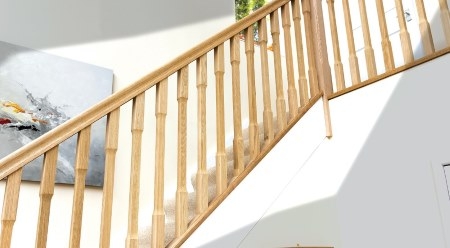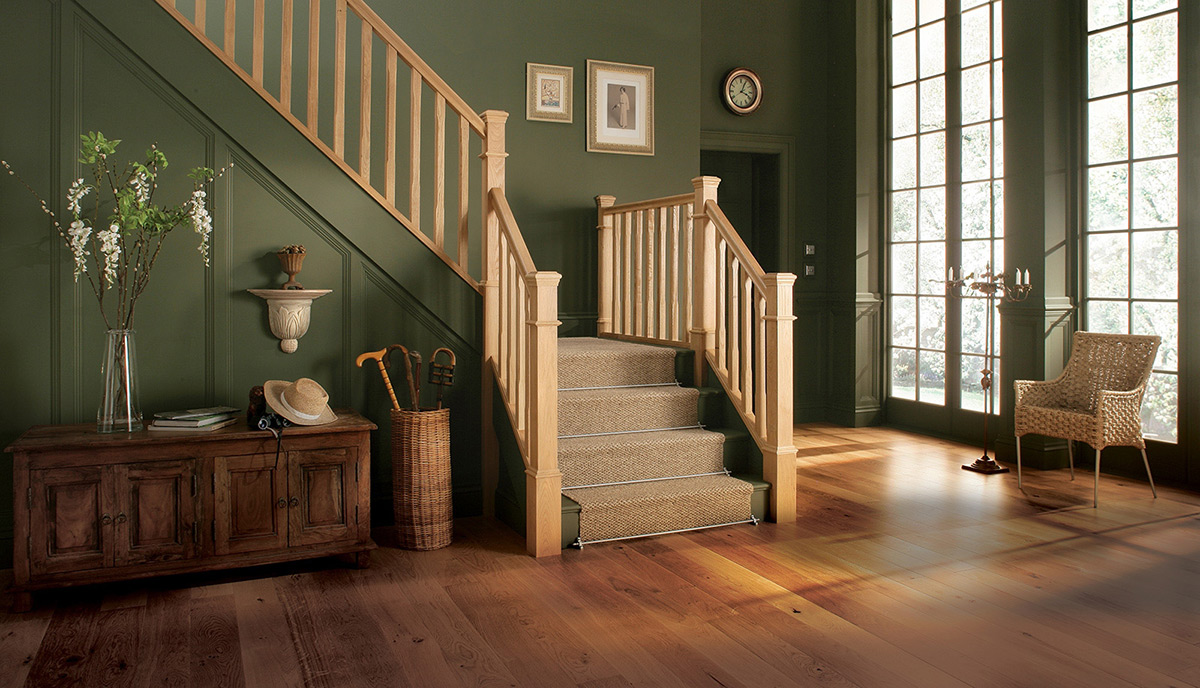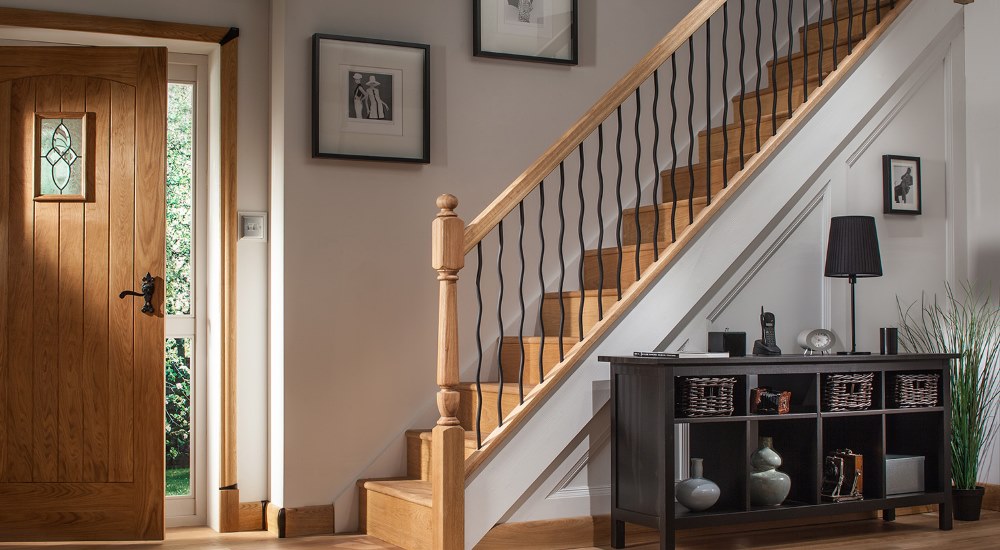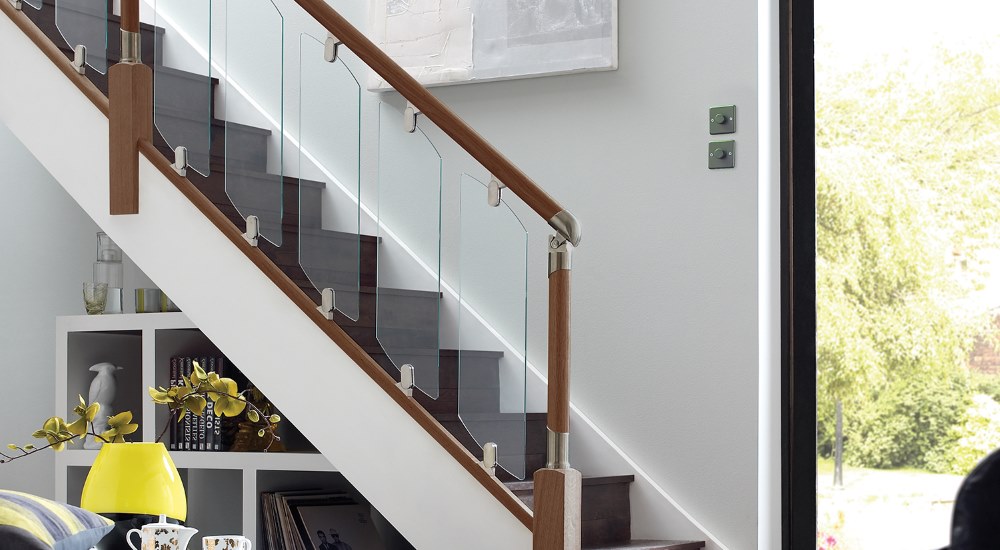Within this guide you'll find information on the following:
Click here to return to Technical Guides.
What is a balustrade?
A balustrade is the structure that encloses a staircase on one or both sides, commonly consisting of:
Together, these parts form a railing or wall that's designed to prevent people from falling off or down the staircase.
Why are balustrades important?
Balustrades serve a vital safety function, but they're important to design. From traditional to ornate to modern, the beauty of balustrades is that they can be used to make a real design feature of a staircase, or alternatively can blend seamlessly with the décor so as not to make too strong a statement.
Parts of a balustrade
Handrail
As the name suggests, the part that you hold on to while climbing or descending the stairs. It sits on top of the spindles or glass, depending on the type of balustrade being installed. It can also be used as a standalone product where it is attached to a wall.
Spindles
Spindles (also known as balusters) support the handrail and protect people from falling through the space between the handrail and the stairs.
Base rail
The part that sits on top of the stair string and to which the bottom of the spindles are fixed.
Newel posts
The vertical posts that sit at the bottom and/or top of the balustrade to support the handrail and secure the whole balustrade.
See our technical guides to key stair parts for further information on the different parts of a balustrade.
Different styles of balustrade
Traditional
A more traditional baluster would include classic elements such as carved wooden spindles and newel posts.
Ornate
An ornately designed baluster makes a statement and may not include spindles at all, but instead incorporate intricate metalwork alongside more traditional elements.
Modern
Modern staircase designs can include few to no elements of a ‘traditional’ balustrade, with materials like toughened glass opening lots of opportunities to create safe and light-enhancing structures.
Visit our online shop to see the full range of balustrade parts and styles we offer
How to choose the right balustrade
Choosing a balustrade for your staircase depends largely on the style and age of your home. You can find detailed advice on selecting the right material and style of balustrade for your home in this guide.
Measurements and building regulations
In order to keep your balustrade as safe and user-friendly as possible, there are a few UK building regulations to follow:
Height
The handrail in a domestic property should be no lower than 900mm on both stairs and landings. If this is a commercial property then handrail on the stairs is 900mm and 1100mm on the landing.
Weight
Handrails in domestic properties must be able to withstand 0.36kN/m (kiloNewton metres).
Width
Spindles must be placed close enough together that a 100mm sphere cannot be passed in between them.
Installation tips
- The handrail and base rail are usually the same length (unless the stairs are diminishing or cut string). Please see our guide, How to measure your staircase, to identify the type of staircase that you have.
- When renovating an old staircase it’s usually better to install a base rail for new spindles to fit into.
- You can use our handy spindle spacing guide to help you calculate the correct placement of the spindles.
- There are a number of helpful how-to videos on YouTube if you choose to install your balustrade yourself. However, it’s a big job that requires a high degree of accuracy and safety, so we would recommend employing an experienced professional if you’re at all unsure.
Style guide
If you’re planning to update your staircase balustrade and need inspiration, take a look at our style guide for design ideas.
Stair parts FAQs
What are your White Primed products made of?
Our white primed product are primed on a hardwood base, which tends to be either tulipwood or birch.
Are your White Primed products a finished item?
No, they are a pre-primed product, so they are ready to receive a final colour of your choosing.
As there are many variations of white, we cannot always guarantee the shade of our white primed products will be 100% to your liking, which is why it is called ‘White Primed’. We advise that a solvent-based top coat works best with our White Primed products rather than a water-based paint.
What is the best product to use on White Primed stair parts?
A solvent-based top coat adheres best to our white primed stair parts, rather than a water based paint. We would advise following the below steps prior to painting:
- Remove any loose coatings.
- Abrade the surface to provide a smooth finish.
- Dust and ensure the surface is clean and dry.
Do your stair parts come pre-finished?
The vast majority of our stair parts come unfinished. We offer some ranges that come pre-finished, such as Fusion, Axxys and Immix, and these are highlighted as being pre-finished in their descriptions.
Since our products are unfinished, you’re free to finish them once installed to the look you want with paint, stain or varnish. We advise finishing your wooden stair parts as they may discolour and stain over time if no finish is applied.
We offer a range of finishes by Treatex which protects and enhances the natural grain of your wooden staircase.
Can I use your stair parts outdoors?
No, our stair parts are designed for internal use only.
Does the infill/spacer come with the handrail and baserails?
All the handrails and baserails that we sell that have a groove in to take a spindle or slot for glass panels come with a compliment of infill (spacer or track).
Do you sell the infill/spacer separately?
No, all the infill/spacer/tracks we sell are pre-packed into our handrails and baserails.
I only want to order a small item; do I have to pay the £15 delivery charge?
If you order online then you will automatically be charged the £15 delivery rate (Monday –Friday all day service). If you call us to place the order over the telephone (0114 2721228) then we can look to do a reduced delivery rate dependant on the item(s) you wish to purchase.
Planning a new staircase




